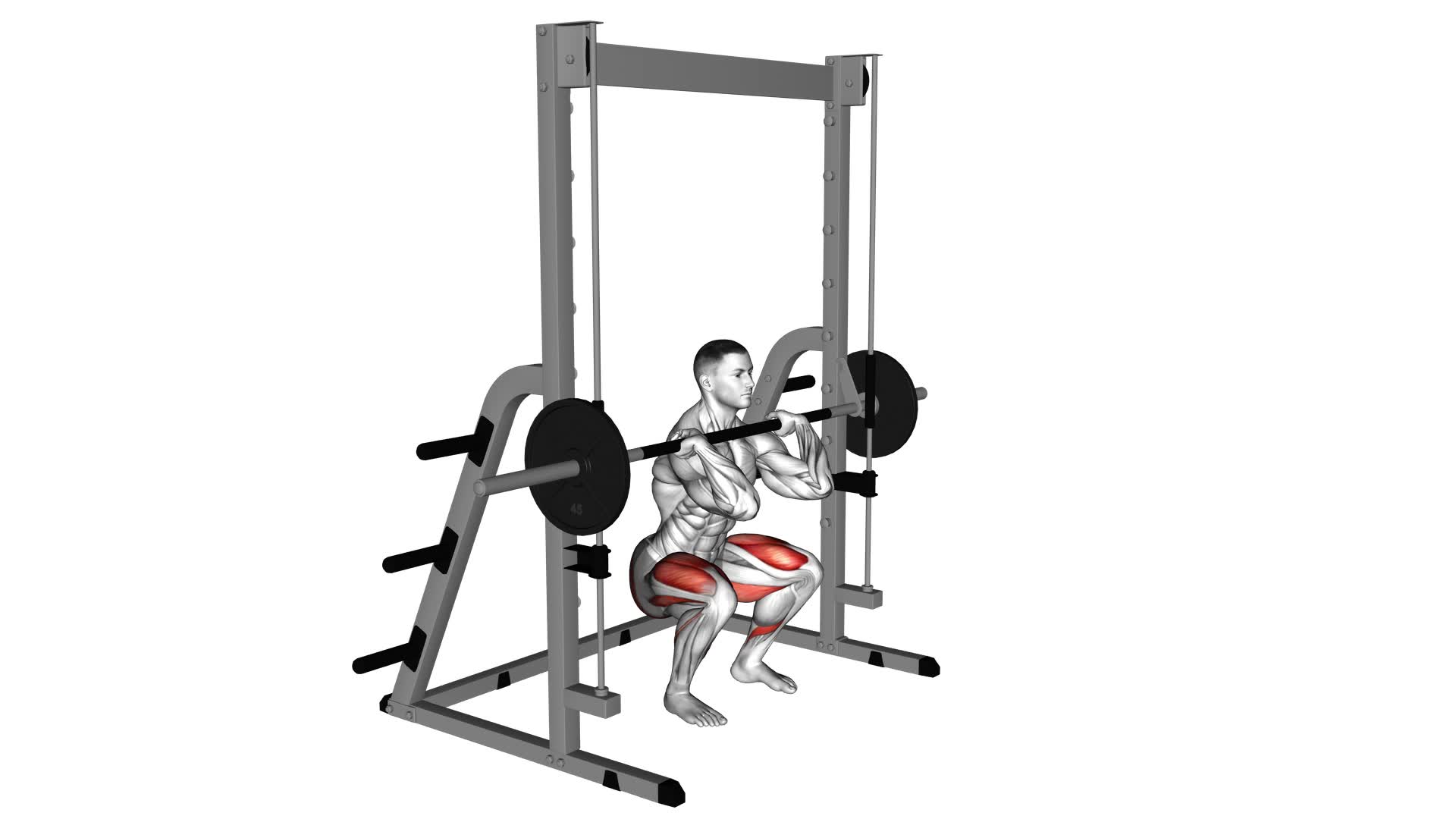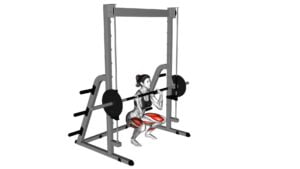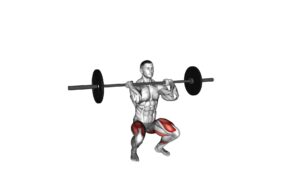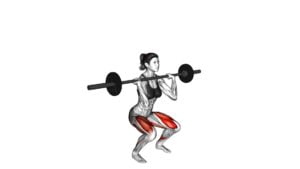Smith Front Squat (Clean Grip) – Video Exercise Guide & Tips

Looking to improve your squat form and strengthen your lower body? Check out our video exercise guide for the Smith Front Squat (Clean Grip).
Watch This Exercise Video
This comprehensive guide will walk you through the proper setup, bar positioning, and step-by-step execution of the exercise.
Learn common mistakes to avoid, variations for different fitness levels, and tips for maximizing results and preventing injuries.
Get ready to take your squat game to the next level with this informative and practical guide.
Key Takeaways
- Targets multiple muscle groups simultaneously (quadriceps, hamstrings, glutes, and core)
- Places less stress on the back compared to traditional back squats
- Improves balance and coordination
- Enhances functional strength in everyday activities
Benefits of the Smith Front Squat
You can maximize your strength and stability with the Smith Front Squat. This exercise offers numerous benefits for individuals looking to improve their lower body strength and overall fitness.
One of the key benefits of the Smith Front Squat is its ability to target multiple muscle groups simultaneously. By performing this exercise, you engage your quadriceps, hamstrings, glutes, and core muscles, helping you develop a strong and well-rounded lower body.
Additionally, the Smith Front Squat is a great exercise for improving your balance and coordination. The clean grip technique used in this exercise forces you to maintain a stable position and control the movement of the barbell throughout the squat. This not only enhances your stability but also translates into better functional strength in everyday activities.
Furthermore, the Smith Front Squat places less stress on your back compared to traditional back squats, making it a safer option for individuals with lower back issues.
Proper Setup and Bar Positioning
To properly set up and position the bar for the Smith Front Squat, begin by placing yourself in front of the Smith machine.
Follow these steps for a proper setup and bar positioning:
- Stand with your feet shoulder-width apart and toes pointed slightly outward. This will provide a stable base for the exercise.
- Position the barbell on the Smith machine at about shoulder height. Make sure it's securely locked in place.
- Grasp the bar with a clean grip, meaning your hands are slightly wider than shoulder-width apart, and your palms are facing upwards. This grip will help you maintain control of the bar throughout the movement.
By following these steps, you'll ensure that you have a solid foundation and the correct grip for the Smith Front Squat. This setup will allow you to perform the exercise safely and effectively, targeting your quadriceps, hamstrings, and glutes.
Remember to keep your core engaged and maintain an upright posture throughout the movement. Proper setup and bar positioning are essential for a successful Smith Front Squat.
Step-By-Step Execution of the Exercise
Once you have properly set up and positioned the bar for the Smith Front Squat, it's time to execute the exercise with proper form and technique. Begin by stepping under the bar and placing it across the front of your shoulders, with your palms facing upwards and elbows pointing forward. Make sure to keep your chest up and core engaged throughout the movement.
Before starting the squat, take a deep breath in and brace your core. This will help stabilize your spine and provide a solid base of support. As you descend into the squat, continue to breathe deeply, exhaling as you push through your heels and drive upwards to the starting position. Remember to maintain proper form, keeping your knees in line with your toes and your back straight.
To maximize muscle activation during the Smith Front Squat, focus on engaging your quads, glutes, and core. As you lower down, think about pushing your knees outwards and squeezing your glutes at the bottom of the movement. This will help to activate these muscle groups and promote proper alignment.
Common Mistakes to Avoid
To avoid common mistakes in the Smith Front Squat (Clean Grip), it's important to pay attention to proper hand placement.
Make sure your grip is firm and secure, with the bar resting on your shoulders and collarbone.
Additionally, maintaining proper form throughout the exercise is crucial.
Keep your chest up, back straight, and knees tracking over your toes to maximize the effectiveness and safety of the movement.
Proper Hand Placement
Place your hands properly to avoid common mistakes when performing the Smith Front Squat (Clean Grip). Correct hand placement is essential for maintaining a secure and stable grip on the barbell. Follow these guidelines to ensure proper hand placement:
- Hand grip: Position your hands slightly wider than shoulder-width apart on the barbell. This grip allows for better control and stability during the exercise.
- Wrist flexibility: Flexibility in the wrists is crucial for maintaining a comfortable and secure grip. Make sure your wrists are in a neutral position, not overly flexed or extended.
- Thumb position: Wrap your fingers around the barbell and place your thumbs on top. This thumb-over grip helps to further secure the barbell and prevents it from rolling forward.
Maintaining Proper Form
To maintain proper form and avoid common mistakes, focus on your body positioning during the Smith Front Squat (Clean Grip).
One common mistake to avoid is improper hand placement. Make sure your hands are positioned evenly on the barbell, with your palms facing upwards and your fingers wrapped around the bar. Avoid gripping the bar too tightly, as this can lead to unnecessary tension in your wrists and forearms.
Additionally, be mindful of your grip width. Your hands should be shoulder-width apart or slightly wider, allowing for a comfortable and secure grip on the bar.
Variations and Modifications for Different Fitness Levels
To accommodate different fitness levels, there are various modifications and variations you can incorporate into your Smith Front Squat routine.
If you're a beginner, simplified exercises such as using lighter weights or performing partial squats can help you build strength and proper form.
On the other hand, if you're more advanced, you can increase the intensity by using heavier weights, adding explosive movements, or incorporating plyometric exercises.
It's important to tailor these modifications to your individual needs and fitness levels to ensure a safe and effective workout.
Beginner Modifications: Simplified Exercises
Achieving a suitable level of fitness can be accomplished through various modifications and adjustments to exercises, enabling individuals of different fitness levels to participate. For beginners, it's important to start with modified exercises that are simpler and easier to perform. Here are three beginner modifications that can help you get started on your fitness journey:
- Bodyweight Squats: This exercise is a great way to build strength in your lower body without the added weight of a barbell. Stand with your feet hip-width apart, lower your body by bending your knees, and then push through your heels to return to the starting position.
- Assisted Push-ups: If regular push-ups are too challenging, start with assisted push-ups. Place your knees on the ground and keep your hands shoulder-width apart. Lower your chest towards the ground by bending your elbows, and then push back up.
- Step-ups: Step-ups are a beginner-friendly exercise that targets your lower body. Find a sturdy step or bench, place one foot on top, and push through your heel to bring your other foot up. Step back down and repeat with the other leg.
Advanced Variations: Increased Intensity Options
As you progress in your fitness journey, you can explore advanced variations of exercises to increase intensity and challenge yourself at different fitness levels. To increase resistance in the Smith front squat (clean grip), you can add weights to the barbell. This will force your muscles to work harder and adapt to the increased load.
Another advanced technique is the tempo variation, where you slow down the lowering phase of the squat and hold the bottom position for a few seconds before exploding back up. This increases time under tension and adds an extra challenge to your muscles.
By incorporating these advanced variations and techniques, you can continue to push your limits and make progress in your fitness journey.
Now, let's move on to the next section where we'll discuss tailoring the exercises to individual needs and customized fitness levels.
Tailoring for Individual Needs: Customized Fitness Levels
As you tailor your fitness routine to your individual needs, you can customize the Smith front squat (clean grip) to different fitness levels by incorporating variations and modifications. Here are three ways to adapt this exercise for your customized programming:
- Depth adjustment: If you're new to front squats or have limited mobility, start with a higher squat depth. Gradually increase the depth as you gain strength and flexibility. Progress tracking is crucial here, as you can monitor your ability to achieve a deeper squat over time.
- Weight selection: Begin with a lighter weight and focus on mastering the form and technique. As you become more comfortable, gradually increase the weight to challenge your muscles and promote further progress.
- Grip modification: If you find it difficult to maintain a clean grip, you can use straps or a cross grip instead. This modification can help you maintain proper form and target the intended muscle groups effectively.
Remember to listen to your body and adjust the exercise accordingly. Customizing the Smith front squat to your fitness level will ensure a safe and effective workout.
Tips for Maximizing Results and Preventing Injuries
To effectively maximize your results and prevent injuries while performing the Smith Front Squat (Clean Grip), follow these steps:
- Position the barbell correctly on your shoulders, just above your collarbone, to maintain stability and prevent strain on your wrists and elbows.
- Engage your core and maintain a neutral spine throughout the movement to protect your lower back.
- Descend into the squat while keeping your knees aligned with your toes and avoiding excessive forward leaning to distribute the load evenly and reduce the risk of knee injuries.
- As you rise back up, focus on driving through your heels and maintaining control over the weight.
- Start with a weight that you can comfortably handle and gradually increase the load as your strength improves.
Frequently Asked Questions
How Many Sets and Reps Should I Do for the Smith Front Squat (Clean Grip)?
For the Smith front squat (clean grip), it's important to consider the number of sets and reps that will give you the best results. Sets and reps can vary depending on your goals and fitness level.
It's recommended to start with 3-4 sets of 8-12 reps, focusing on maintaining proper form and technique throughout each repetition. This will help build strength and endurance in your lower body while minimizing the risk of injury.
Can I Use Dumbbells Instead of a Barbell for the Smith Front Squat (Clean Grip)?
Yes, you can use dumbbells instead of a barbell for the Smith front squat (clean grip). This is a great alternative that allows for more stability and control during the exercise.
The dumbbell variations of the Smith front squat can provide similar benefits to the clean grip, such as targeting your quadriceps, glutes, and core muscles.
It's important to maintain proper form and gradually increase the weight to challenge your muscles effectively.
Should I Wear a Weightlifting Belt for the Smith Front Squat (Clean Grip)?
When it comes to the Smith Front Squat (Clean Grip), wearing a weightlifting belt can have its benefits. It provides additional support to your core and lower back, helping to maintain proper form and prevent injury.
However, if you don't have a weightlifting belt, there are alternatives you can try, such as using a towel or a resistance band to provide some extra stability. Just make sure to focus on maintaining good posture and engaging your core throughout the exercise.
Can I Do the Smith Front Squat (Clean Grip) if I Have Knee Pain?
If you're experiencing knee pain, it's important to listen to your body and take care of yourself. The Smith Front Squat (Clean Grip) may not be the best exercise for you in this case.
However, there are alternative exercises you can try to work your lower body without aggravating your knee pain. Remember, the Smith Front Squat offers benefits such as improved lower body strength and stability.
Consult with a medical professional or a certified trainer to find the best exercises for your specific situation.
Is the Smith Front Squat (Clean Grip) Suitable for Beginners?
The Smith Front Squat (Clean Grip) can be a suitable exercise for beginners. It provides a stable platform for learning the proper form and technique of a front squat. Beginners can modify the exercise by using lighter weights or starting with just the barbell.
The clean grip offers several benefits, including improved upper body strength and stability. By incorporating this grip, beginners can engage their core and upper body muscles more effectively during the squat movement.
Conclusion
In conclusion, the Smith front squat is a highly beneficial exercise that targets the lower body muscles while also improving core strength and stability. By following proper setup and bar positioning techniques, executing the exercise step-by-step, and avoiding common mistakes, you can maximize your results and prevent injuries.
Additionally, there are variations and modifications available for different fitness levels, allowing individuals to tailor the exercise to their specific needs. Incorporating the Smith front squat into your workout routine can lead to improved strength, muscle definition, and overall fitness.

Author
Years ago, the spark of my life’s passion ignited in my mind the moment I stepped into the local gym for the first time. The inaugural bead of perspiration, the initial endeavor, the very first surge of endorphins, and a sense of pride that washed over me post-workout marked the beginning of my deep-seated interest in strength sports, fitness, and sports nutrition. This very curiosity blossomed rapidly into a profound fascination, propelling me to earn a Master’s degree in Physical Education from the Academy of Physical Education in Krakow, followed by a Sports Manager diploma from the Jagiellonian University. My journey of growth led me to gain more specialized qualifications, such as being a certified personal trainer with a focus on sports dietetics, a lifeguard, and an instructor for wellness and corrective gymnastics. Theoretical knowledge paired seamlessly with practical experience, reinforcing my belief that the transformation of individuals under my guidance was also a reflection of my personal growth. This belief holds true even today. Each day, I strive to push the boundaries and explore new realms. These realms gently elevate me to greater heights. The unique combination of passion for my field and the continuous quest for growth fuels my drive to break new ground.



